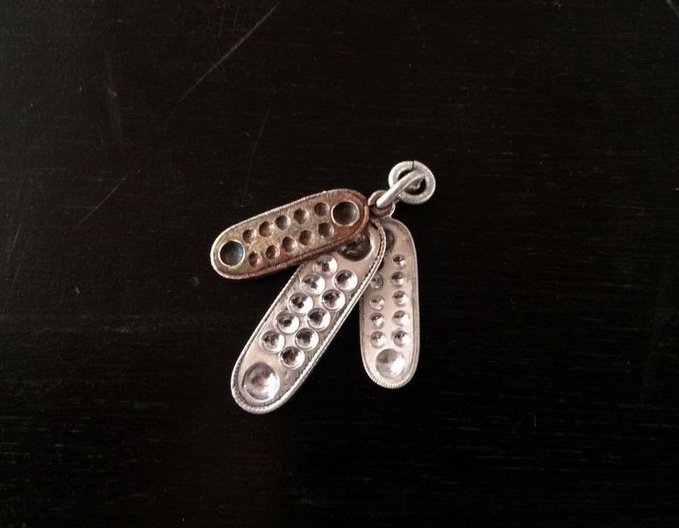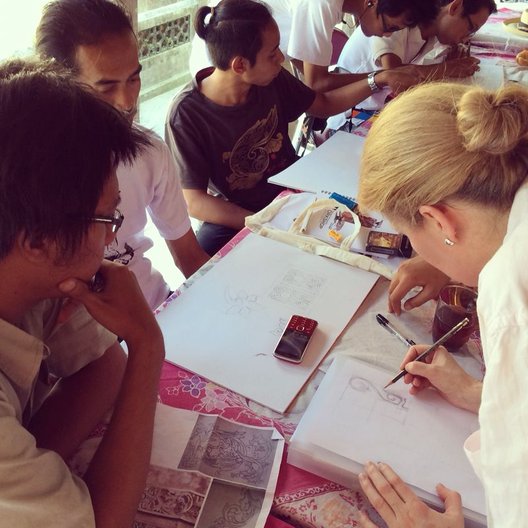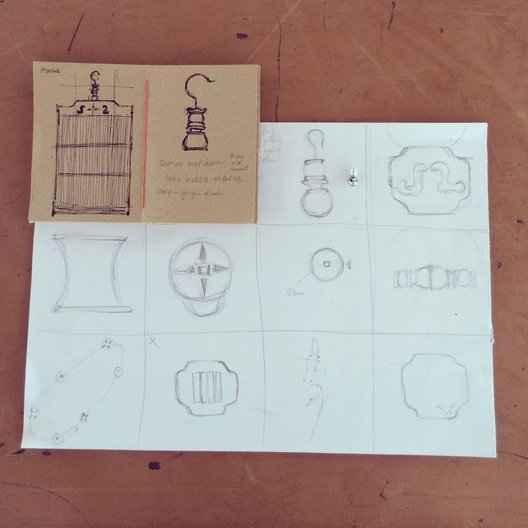23 July 2014
by João Guarantani
In his second and final post from Kotagede, Indonesia, Simon Fraser, from ultra-indigo, reports on the Design and Innovation workshop he led in March 2014. The programme was developed in collaboration with the British Council, Arkom and the AirAsia Foundation:
Our return journey to Kotagede takes a long time from my north London home, more than 28 hours door to door. It’s hot and humid as we arrive in Yogyakarta but within an hour we are in the village checking the setup for the workshop. It’s impressive, everything we need is ready and the preparations add to the rising sense of excitement that pervades us all. Texts alert everyone to our arrival and a small fleet of mopeds and motorbikes bring the young team and some of the participants to greet us. Although feeling grubby and exhausted after the journey, no one seems to notice. The warmth of the welcome is, if possible, stronger than my original visit and Elizabeth is immediately drawn into the group. Elizabeth and I have worked together for years but we are both anxious – there is a massive amount to do in the week ahead. We have been planning the program since the original visit weeks ago. It is not clear what design experience the participants have; their backgrounds, apprenticeships and life experiences seem quite diverse and they range in age from 18 to 50 plus. In fact as we discover when we ask the participants to bring examples of what they make, to demonstrate their skills, it is apparent that this is not a master craft community of one skill but of at least five or six. Fantastic, but how will this fit with what we have planned for the week and what happens if we take this disparate group through the same set of classes?
It’s the first morning and we arrive to find half the class sitting around the courtyard, or under the architectural teak canopy that becomes the main focus for the classes. As word of the classes has spread, numbers have risen. We are up to twenty two! In the rooms around the courtyard digital projectors are set up, woven palm mats unrolled and in one open veranda a row of tables announces the space for refreshments. The participants load up their plates, grab their tea and sit down at the horse shoe arrangements of tables. The Kotagede silversmiths workshop begins with the local head man welcoming us all to this family space. A space he associates with happy memories as he and his wife were married here many years ago and he hopes that we also will have happy memories by the end of the week. Mun Ching Yap for the Air Asia Foundation graciously replies, in turn we thank everyone for their generous welcome and Evonne Mackenzie from the British Council gets proceedings underway.
Intan from Arkom, the local community organisers, set the framework for the week. Then it is our turn. We will be dependent on translators but as Mayang and Intan get into full swing it is clear that they are brilliant and this will work well too. In fact by the end of the week we have a wonderful fluidity established between us all, the best we have experienced and one of the reasons that we succeed.
To build an understanding of Design and Innovation and a strategy for future routes to market for the participants is a multi facetted task. In preparation ultra-indigo researched the work of the village, locating artefacts in museum collections and tracking back through previous initiatives to get a real understanding of the context. Working out what the participants might need and how to create a cultural shift to benefit the participants in the longer term, rather than a short term quick fix. During our research fascinating insights emerged. Whilst the community would appear to have been in the area as gold and silver workers for 400 years, earlier fine metal smiths of a previous kingdom worked in the area for at least the previous 500 years! Together, perhaps a 1,000 years of continued practice. This raised the question, what happened to the earlier skills and knowledge when the forefathers arrived? How much of the work from the past 400 and previous 500 years are the villages aware of? It is often true that many master-craft communities, who make the finest work, may be known across the world but unless the community has kept drawn records such work can be unknown locally or recognised only through oral history. Our images from international museum collections are a revelation. Some of the makers have been trained to make the most ambitious items, whilst some of the work from 700 years ago draws laughter of recognition. ‘We’ve made some of those. Visitors came with photographs and asked us to copy that necklace. We didn’t know it was from Java or Kotagede.’ Cultural tourist shopping at a whole new level!
As the week progresses the differing routes through which work is sold and commissions are obtained and organised emerges. These are crucial to the future of the village and are familiar to insiders but it is clear that historically the diversity of sales was far more extensive than is now apparent. Many of the traditional routes to market no longer exist in a viable manner and need re-connecting. In the past the village, like many master-craft communities, has been dynamic, socially relevant and self sufficient, relying on reputation to draw in work. Today the craftsmen need to design, innovate and strategise their practice to proactively sell if they are to compete against low cost rivals.
Drawing is a key skill for designers. If you cannot demonstrate to yourself what you are thinking, how is it possible to begin explaining to others especially commercial clients? We wondered how many in the class could draw, and after a swift sketching exercise, results showed that very few had the skill, or even if they did, had practiced it at all. This was bad news as making a model or a prototype takes time and money and drawing can cut costs and is essential for design and innovation. Two days of classes in and it is clear that the quality of the skills in Kotagede is not only high but also that a core team of the craftsmen are flexible in their approach and with a range of transferable skills, which rapidly come to include drawing! Some of the drawings are excellent and one or two clearly could be brilliant with practice. A huge sigh of relief all round as everyone realises the value of this new skill. The same thing happens during the design classes. Ideas initially appear slowly so we begin the design generation class. This process encourages fast delivery of ideas for designers, it’s a traditional fashion industry approach with enduring value, although strangely little used in jewellery design today. This class seems an intense and very new experience so we crank up the music selected by the younger members of the group to keep the energy levels high as the newly formed Design Studio Kotagede booms out and the pace picks up!
The guys take to the work loading with good humour, concentrating hard and supported by lots of tea, cigarettes and cakes. In conversation we identify each participant’s strongest idea of the day and set the evening’s home work: a prototype in silver from each, to be made overnight. Indignation and outrage! I wade in telling everyone I’m a jeweller too and it will only take an hour. Intense arguments breakout around the class. ‘It’s alright for you in London Simon, you can buy the materials you want, we have to make up our materials from silver scrap and grain before we can start to make the pieces.’ They are right of course, but survival here is about speed. For the community to design for new markets not only will need high quality but they must also innovate to find the speediest ways to delivery. I’ve also trained as a jeweller and most of these designs can be made fast, so I insist, ‘You have an hour, and an extra half to make the material.’ A moments pause and then a huge laugh and a round of applause. I’m right. These are very skilled men and I knew they could do it. It was just did they want to? We had two days left to make this work.
Early the next day but 30 minutes later than usual, everyone arrives all at once in a flurry of engines and swooping jewellers. At first they are shy to reveal their work to each other, to us and the cameras for the wider audience. As they do, it’s fantastic! Collectively we have made a huge leap forward.
Reassured and excited the next classes push the design ideas forward within a broader understanding of design within a strategy for innovation and sustainability. We all worked hard, aware of the pressure of time and the increasing sense of urgency and achievement. Changing the pace to provide a brief pause and contextualise the process, we showed a wide range of websites identifying comparative work from the global industry that has relevance to their design and strategy. It is fascinating to see which brands are recognised here and by whom. The meaning of globalisation takes on a new relevance as the range of competition and opportunity becomes clear. All week we had been explicit in our belief in the quality of skill that this community holds now and its potential for the future. As the craftsmen look at images from New York, Hong Kong, London, Paris and Sao Paulo it is clear that they understand our insistence and that they can see a new place for their practice and themselves.
How to get there? That’s the next stage and it’s already on the way.


